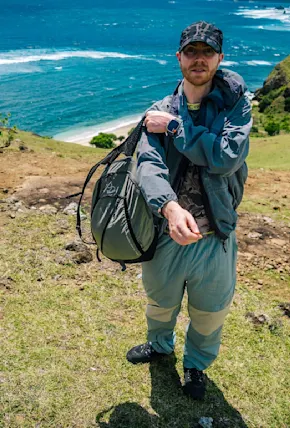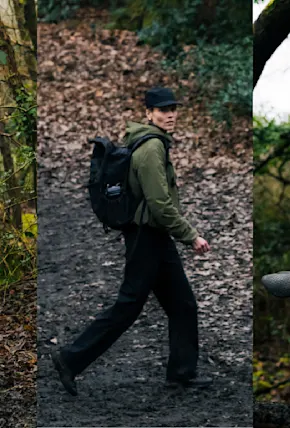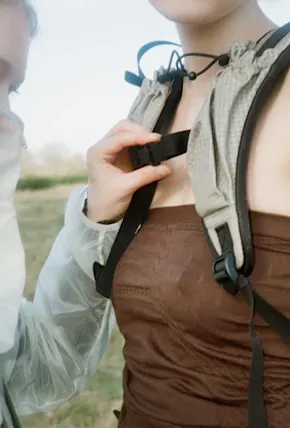As a niche aesthetic that rose to prominence in the mid 2010s within the wide and ever-expanding world of outdoors and fashion-adjacent apparel, techwear combines highly intentional, overtly functional design with a futuristic, occasionally military-inspired design sensibility. This translates physically to water-resistant and technical details ripstop materials, Gore-Tex fabrics, taped seams, waterproof zippers, and so on—the very materials common to outdoor clothing for backpacking, rock climbing, and backcountry snowboarding. But what makes it different from other outerwear?
Typically, the male-focused techwear aesthetic uses a more muted color palette (darkwear is another term for techwear), is obsessed with futurism, and speaks a more elevated design language; it's sleeker, and directed more towards high fashion sensibilities and urban lifestyles than your average Patagonia or TNF rain jacket. It also often leans on novel, over-designed features with excessive functionality that may not be totally necessary, or even practical. Unconventional pocket placement, excess webbing, exterior clasps and straps are all a part of techwear's visual definition. Think what Neo might wear while hiking in The Matrix.
Born on the Internet, techwear style grew up on community-focused platforms like Superfuture and Reddit. As a result, it can skew cyberpunk, and at times, even feel like pure cosplay. When it leans Harajuku warcore, this is often the case. Cyberpunk techwear on the other hand, feels more natural, as the genre owes a lot to famed science fiction and noted lover of clothes William Gibson (more on this connection below). Although techwear had its heyday a handful of years ago, the functional outdoorsy aesthetic still very much remains in the Zeitgist—you can't walk around lower Manhattan without seeing someone kitted out in high end technical outerwear, regardless of season and weather. The style may have evolved beyond cyberpunk futurism and cyberpunk clothing, techwear remains on our radar.
Messy definition aside, techwear fashion is easy to recognize once you know what to look for. Scroll on for a modest survey of some of the more well known and significant techwear brands still influincing fashion today.
11 Best, Most Influential Techwear Brands to Know

Acronym
Acronym
Acronym is synonymous with techwear. Started by Germany-based designer Errolson Hugh in 1994 as a design agency, working with clients like Burton Snowboards on their deeply influential AK and Analog sub-lines, Acronym eventually set off as its own label and has since become popular in the hypebeast community. The brand is known for monochromatic blacks and unusual silhouettes that could be described as sci-fi meets street fighter—or "goth ninja." The brand operates with streetwear-style drops, building exclusivity by only releasing a maximum of 15 pieces with each collection. One recent drop featured the J93-GTPL Paclite Plus Parka, characterized by a variety of zippers and waterproof snaps for customizable wearing styles and an almost dystopian, cyberpunk look. Acronym drops tend to sell out immediately at insane prices despite the brand's minimal advertising efforts, but that's just another example of how excess and function characterize this futuristic apparel brand.

Stone Island Shadow Project
Stone Island Shadow Project
Also designed by Acronym's Errolson Hugh, it comes as no surprise that the Stone Island Shadow Project has been pushing the envelope of fashion for years. Experimentation with hand dyes and unique fabrics like the 40616 Track Jacket. This features several different experimental techniques such as dying with corrodible colors and pigment, lacquer, and corrosion printing.

Veilance
Veilance
Veilance is a sub-label of Arc'teryx—you know, the hugely popular little brand from British Columbia that originated as a climbing company before quickly expanding to apparel and equipment for all outdoor sports, earning serious clout in city streets in the process. A favorite of legendary science fiction author and inventor of "cyberspace" William Gibson, who not coincidentally was briefly involved, as a consultant, in the creation of Veilance, the sub-brand was born in 2009 as Arc’teryx's take on men's techwear pieces designed for a high fashion audience. Muted neutral colors, extremely high tech materials, and long, minimalist silhouettes like the Lexer Coat distinguish the brand while maintaining the technical superiority Arc’teryx made its name on.

System A
System A
System A is another Arc'teryx sub-label, and the company's newest. Aiming to reach a younger audience, System A has a more casual feel to it than other techwear brands, including Veilance. Although still performance based, it ups the style component with a familiar minimal aesthetic common to techwear clothing that's more playful than the company's other offerings. The Olena Komorebi Cropped Jacket, for example, uses Gore-Tex's waterproof/breathable fabrics along with a cut that wouldn't be suitable for mountain endeavors, affirming its position as a piece more suitable for life around town.

Houdini
Houdini
This women-founded Swedish label focuses on sustainability with an aesthetic rooted in function, practicality, and minimalist design. Though the brand’s color story leans a bit brighter than one would typically expect from a brand labeled techwear, its silhouettes and drape-y, layer-heavy styling firmly root it in this category. Consider Houdini an outdoorsy version of your archetypal techwear, designed to withstand a Scandinavian winter and mountain expeditions, Houdini's technical apparel and outerwear has utility as well as sustainable innovation in mind. In its most recent season, 100% of Houdini's fabrics are recycled, recyclable, renewable, or biodegradable. Items like the W's D Jacket are made from recycled biodegradable fibers (although the jacket as a whole is not biodegradable). Once you wear out one of Houdini's techwear jackets or techwear pants or other products, you can return them to the company to be recycled and go to the creation of new items.
Isaora
Isaora
Started in New York City by Ricky Hendry and Marc Daniels in 2009, Isaora quickly became a forerunner in techwear and redefined the definition of activewear. Though their presence remains modest, their influence is still relevant. Quality and performance-driven, they created clothing for urban life that could double as sportswear. Items like the UPT Zeus Stealth Shell exemplify Isaora's futuristic aesthetic with a structured and asymmetrical silhouette. The shell also features asymmetrical pockets and reflective details.

Goldwin
Goldwin
Goldwin evokes the perception of effortless style and function. The Japanese outdoor company also owns Nanamica, The North Face Purple Label, among other coveted Asia-specific sub-labels of American and European brands. Minimalist function and refined designs are the pillars of Goldwin, and though it may not be on every Techwear list, we feel its spot is well earned due to the ability to transform technical mountain apparel into urban-ready Japanese streetwear pieces for men and women that are well-aligned with current fashion trends. The Pertex Shield Air Pullover exemplifies its chic aesthetic while providing a piece that can still protect you from the element. Waterproof and lightweight and it is made with recyclable materials that will keep you dry, comfortable, and stylish.

The North Face Black Series
The North Face Black Series
The North Face Black Series is yet another techwear offshoot of the well-known TNF brand. (A lot of techwear brands are tributaries of or collaborations with larger companies that exist under the same umbrella, though with their own distinct style.) The Black Series' operating terms are performance and innovation. Items like the Technical Mountain Vest highlight water-resistant nylon and an array of functional zippered pockets. The color scheme is bold, with solid blacks, whites and nylon fabrics that make each piece a unique statement.

HH-118389225
HH-118389225
With its convoluted name, HH-118389225, an offshoot of Helly Hansen, reimagines pieces from that brand's cold water sailing line to create a sleek, ready-to-wear urban techwear capsule. It features cargo pants with a variety of detachable panels as well as modular parkas with reflective high-visibility contrast like the Purple Nylon Jacket, t-shirts with zippers, windbreakers, and more. Many of the fabrics it uses are water-resistant with features like detachable pockets and multiple zippers, affirming techwear's tendency to overload the wearer with functionality.

Nike ACG
Nike ACG
Holding a largely ceremonial spot on this list due to its 2014 rebirth under the watchful eye of, you guessed it, Errolson Hugh, Nike ACG helped make the goth ninja aesthetic mainstream with one fell swoop—and a whole lot of darkwear aka black hoodies and black joggers. Though Hugh's interpretation of the Swoosh's beloved GORPwear line was short-lived, it was heavily influential, informing the following decade's fashion obsessed with merging urban sentiments and outdoors apparel. Today's ACG (which has since its 1989 inception stood for for All Conditions Gear) is considerably more crunchy, with an identity more informed by hints of nostalgia (notice all the film photo lookbooks anyone?) than the future. Still, the use-case and style remain both urban and outdoors inspired and driven. Nike ACG's Cargo Short, for example, is a techwear short that uses core hiking style as a foundation for a silhouette that can be used in the mountains or in a city. Bold colors and prints abound, and, unlike almost every other techwear brand, ACG is actually affordable.

Adidas Y-3
Adidas Y-3
High fashion meets advanced sportswear in Adidas' Y-3 collection. The brand is made in collaboration with Japanese fashion designer Yohji Yamamoto and draws the Y from his initials (the 3 represents Adidas's three stripes). Trademarks include plenty of unique techwear shoe designs, but there are also highly tailored items like the Y-3 Classic Sport Uniform Cargo Pants. Everything is made with functionality and the urban lifestyle in mind.
For more outdoor clothing meets high fashion check out 18 East & Bodega Functional Streetwear collab Inspired by New England







